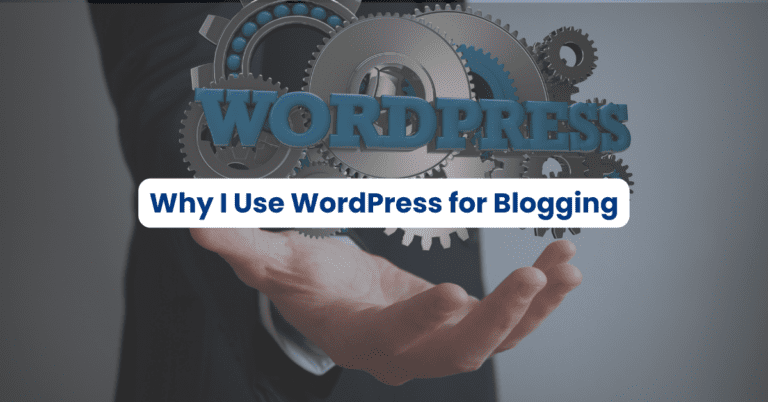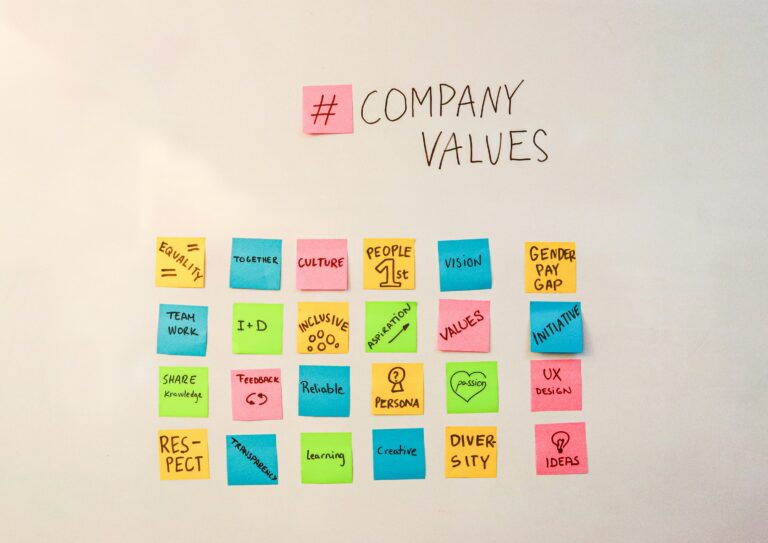Did you know that creating blog posts isn’t all there is to build and implement a content strategy?
Yes, you need to create blog posts to drive traffic and engagement. And to get sales.
But a robust content marketing strategy cannot rely on blog posts alone.
You need to provide your audience (and search engines) with a variety of content types in different formats.
Let’s look at alternatives to blog posts that you should create.
16 Alternatives to Writing Blog Posts to Support Your Content Marketing
Here’s a breakdown of the top alternatives that aren’t replacements for your blog but are necessary to help you grow your brand.
1. eBooks
Sometimes, your audience wants in-depth information about a certain topic.
eBooks provide your audience with detailed content on topics that are too big to cover in blog posts or other shorter pieces of content.
Here’s an example from Shift a performance communication agency. They have developed an ebook on ‘The Future Of Marketing’ a topic closely related to their services.
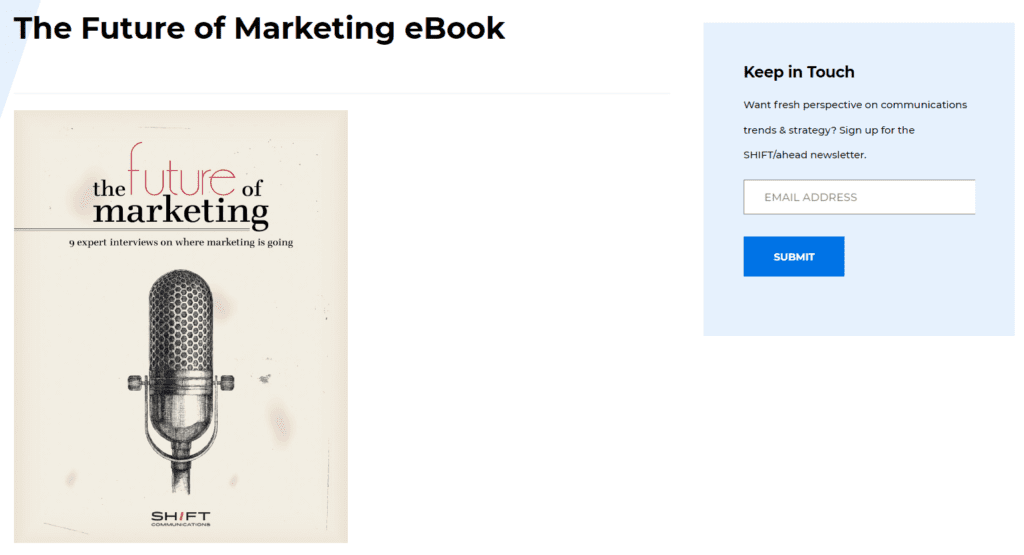

Your readers will also assume that because you’ve written an ebook, you’re offering more value. An ebook allows you to add stories and images and explore a topic thoroughly.
You can also turn your ebooks into compelling lead magnets by gating them behind email forms. In this way, you’ll build your email list and offer a different content format for a topic.
2. Interactive Content
Interactive content is perfect to engage your audience, create conversations, and get them to spend more time on your website.
Examples of interactive content include polls, quizzes, assessments, and calculators.
The polls that you often come across on social media platforms are interactive content. Like this SEO scientist poll on Linkedin. They’re killing two birds with one stone.


First, they’re getting people to connect with them. Second, they’re creating a need for their services.
There are many other ways you might create or leverage such tools; let’s see what they are:
- Use the poll option available on Twitter, Instagram, and other platforms to get quick feedback from your audience.
- Try paid third-party quiz makers like Outgrow and Quiz Cat to create quizzes specific to your niche.
- Use paid calculator platforms like Calculoid to create custom calculators that can be embedded on your website.
- Find WordPress plugins to build and add such content to your website.
My best advice is to use brand new white-label tools that use AI to build such interactive content on your site.
The previous options are expensive and need time and effort to get set up. But thanks to AI there are new tools available where you can offer a whole suite of content generators and calculators on your site. It’ll take minutes, and it will be low-cost.
3. White Papers
White papers are similar to ebooks, but they tend to focus on business-related topics and include the latest industry research and data.
They provide a more in-depth look at relevant solutions and strategies in your field of work. They can be invaluable resources for current customers who want to keep track of trends and get comprehensive information on specific topics.
White papers help you collect emails, names, and other details. And you can use such information to grow your customer base.
They also help boost your reputation and authority in your field.
4. Infographics
Some people just don’t have the time (or patience) to read lengthy blogs or ebooks, and that’s where infographics come in.
Infographics are a great way to quickly explain an idea without using too many words. They help you capture attention with visuals and can be incredibly powerful when used correctly.
For reference take this Creatopy’s example. It shared infographics containing tips to help you stay productive and focused while working from home. It does contain some text but its visuals are pretty attention-grabbing.


They help you simplify complex topics and explain ideas in a way that’s easy to understand. And they’re great to share across various social media platforms and websites, giving them more reach and engagement.
Not to mention, they’re highly linkable. If you want to drive more backlinks to your website, you should create infographics with a design tool like Canva.
5. Videos
Videos are an incredibly effective content type for driving traffic and engagement. They are a great way to tell stories about your brand, give a face to your business, and leverage platforms like YouTube and other social media networks.
They also help you appear as a top search result if your competition hasn’t created any helpful video content for a specific subject.
Take this Shopify Plus’s landing page video for example. It in a very simple way shows how to go big with your brand with the help of Shopify Plus.
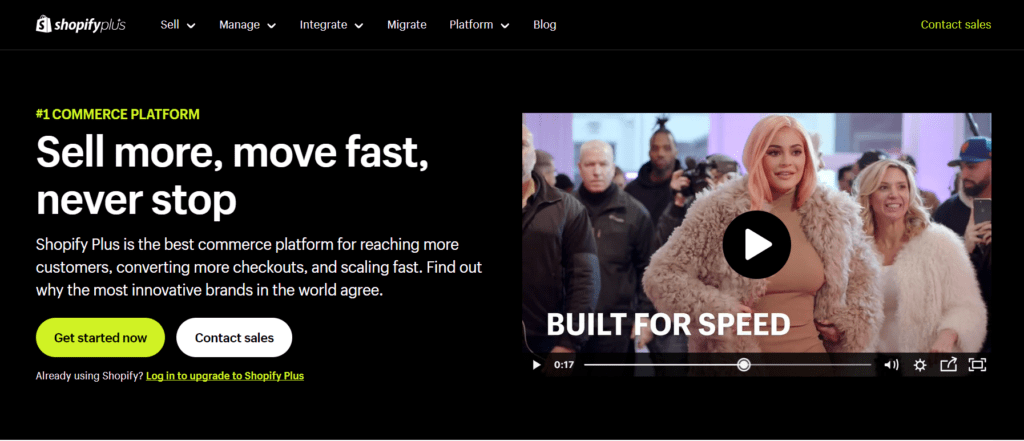

It shows some brands, including some popular ones, and some advantages you’d enjoy by using Shopify Plus in text. But all it al the video is engaging, and explain the job of Shopify Plus without much fuss.
Now you don’t need an expensive or elaborate setup to start making videos.
Hence, I recommend using your phone camera with a stand if you want to speak directly to your audience. Or use Loom if you need to record your screen and share information.
By adding video content to your blog, website, and social media channels, you’ll get more views and drive traffic to your site or product pages.
6. Live Streams
Live streaming is becoming increasingly popular for brands who want to engage with their audience in real time. They allow you to create conversations and answer customer questions on the spot.
Platforms like YouTube Live and Facebook Live are great for hosting live streams, but there are other options available too.
Live streams help you cultivate relationships with your audience and create a sense of community. However, you do need to build a decent audience and make them commit to attending your live stream for it to be useful.
Once you get an engaged audience, use live streams to launch products, provide training sessions, answer customer questions, host Q&A’s, or simply connect with followers in real time.
7. Podcasts
According to Exploding Topics, there are 464+ million podcast listeners around the world.
From personal experience, I know that there are hard-core podcast listeners who prefer this medium over every other one out there.
People often listen to podcasts at times that they can’t read or watch videos – for example, when they drive, work, or do house chores.
Take Sephora’s podcast which is available on Apple podcasts called Lip Stories for instance. It contains a series of conversations between beauty insiders, industry experts, and well-known figures in the beauty world.
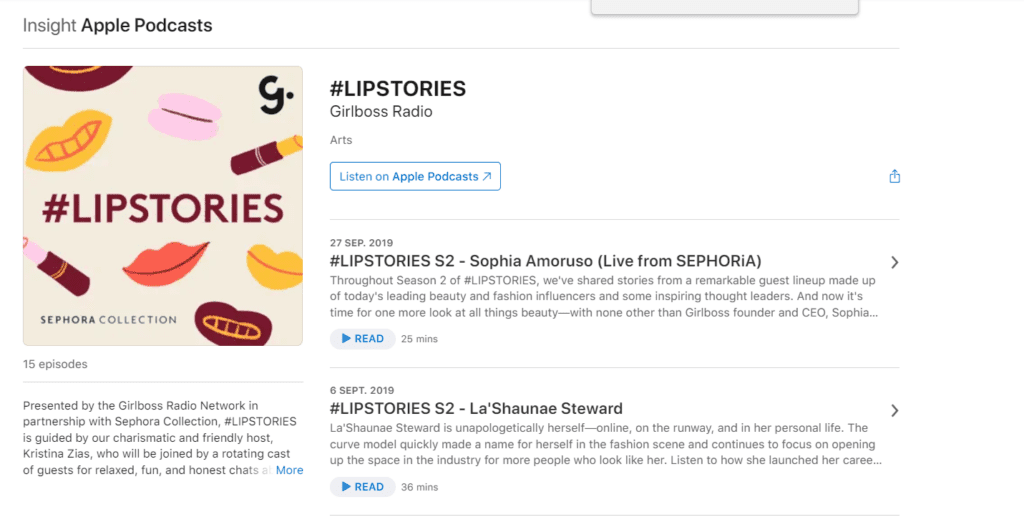

They share chats about self-image, how to feel more confident, and delve into beauty trends. So anyone interested in beauty trends can turn this on and know all about ongoing beauty trends and tips.
Podcasts are also great for reaching people who like ‘on-the-go’ content, which makes them perfect for busy people.
So, don’t ignore the potential to tap into millions of listeners for free. Repurpose your blog posts and other content into podcasts and start creating an engaged following in this format.
8. Slideshows
Slideshows aren’t just for school presentations and business meetings, they’re also a great way to tap into more of the market. How?
By offering an alternative content format where your audience can get the key highlights of your information via a slide deck.
You can turn your blog posts into slideshows with tools like Google Slides, FlexClip, Canva, and Visme or embed videos within the slide decks and create an interactive experience.
Share it on SlideShare for maximum reach or embed it in your blog post or website.
And also, note that you can create a slideshow-like or carousel experience on LinkedIn, Facebook, and other places. Just create a series of images and post it as one combined piece.
Here’s an example of one I have created on LinkedIn. You can have a look at it for better understanding.
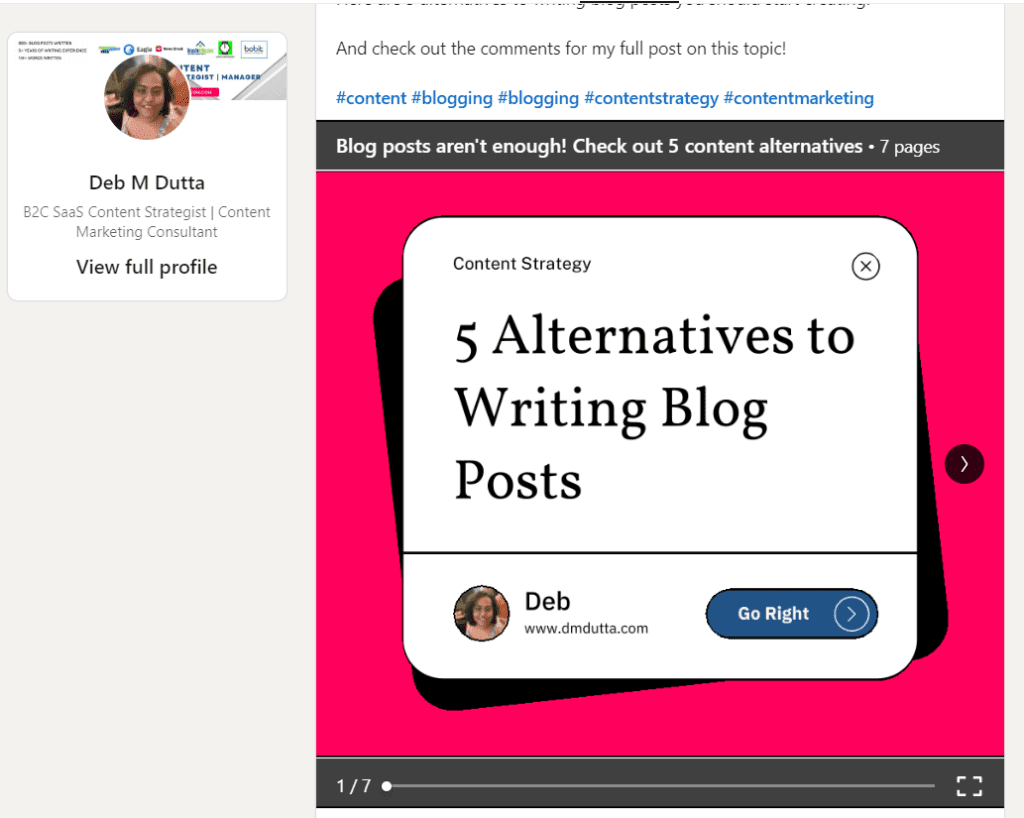

This is an important alternative to blog posts. And, you get to repurpose your blog content! Just copy and paste the main points from your blog post and create a slide for each point.
9. Case Studies
Case studies are great for showing the success stories of your products or services. They help validate your claims and win the trust of potential customers.
And they don’t have to be long pieces of content. Case studies can be short and simple stories that you can share in blog posts or even on social media.
For example, take this case studies page of Ethics Unwrapped a website by the Center for Ethics at The University of Texas. This page has a collection of different case studies related to ethics and morality.


Each one comes with an explanation, a video, and some discussion questions. The university is using case studies to draw the attention of students.
But, if you want to really dive deep into a case study, you can create a longer version. Have your customer explain their experience and the results achieved from using your product or service.
This will help you build more credibility and trust with your audience. Again, they’re also great for driving links to your website and sharing on social media.
So, don’t forget to create case studies and play around with how you present them to get the best results.
10. Checklists & Guides
One of the best content formats for creating evergreen content is checklists and guides. This type of content helps you quickly explain information without having to dive too deep into any one topic.
You can create short checklists and guides in the form of downloadable PDFs or even share them on social media.
These are great for topics with lots of steps and for people who want a quick overview of a subject.
So, if you have recurring topics that your audience needs help with, then creating checklists and guides is a great way to build your email list.
Here’s an example, a travel company that wants to sell tours to Turkey might create a checklist of ‘Dos and Don’ts When Visiting Turkey’. Or ‘How to Pack Everything You Need for An Overseas Trip in Your Carry On’.
And, of course, don’t forget to include a call-to-action in your checklists and guides. You can use it to encourage readers to sign up for your newsletter. Or better yet, create a gateway where people need to enter their emails to access your content so you can nurture them into paying customers down the line.
11. Social Media Posts
Many people treat social media content as an entirely separate entity from ‘content’. But that’s not the case.
So, don’t forget to create content in social media post formats. That means creating quotes, funny images, GIFs, memes, and other types of posts.
Like in this Spotify Instagram post, Spotify is promoting its app’s smart shuffle feature through a video. You can do this too for your products or services.


This is a great way to engage with your audience and build relationships with them.
Plus, it’s also a great way to drive traffic to your blog posts, website pages, or products.
Make sure that you align your content creation so that your blog content, video content generation, and social media reflect and amplify the same message.
That way, you’ll be able to create a cohesive experience for your audience that will keep them coming back for more.
12. Expert Panels and Interviews
Your audience needs insights from people who aren’t only in your company.
So, why not create content featuring interviews with thought leaders and industry influencers?
Interviews are great for getting insights from experts that you can’t get anywhere else.
You can conduct interviews via video, audio, or text. And then share it on your blog and social media.
This is a great way to tap into the expertise of people outside of your company and create content that is valuable and engaging.
Plus, you can use interviews as a form of link-building. Ask the interviewees to share your content on their own channels and you can get some valuable backlinks in the process.
Expert panels and interviews also showcase that you’re connected to key people in your industry and add credibility to your brand.
13. User-Generated Content
Nothing builds goodwill and engagement like a piece of content that comes directly from your audience.
User-generated content (UGC) is an affordable and effective way to get your existing customers and followers to create content for you.
You can ask your audience to tag you in their posts, use a hashtag related to your brand, or create content featuring your products.
Like Salsa Jeans a Portuguese jeanswear brand. They created the hashtag #Salsajeans to encourage their customers to share photos of themselves wearing Salsa Jeans outfits.


This allowed them to engage with their customers in a meaningful and powerful way and get a source of unlimited user-generated content.
This is a great way to get customer reviews and let people know how others are using your product.
Plus, you can repurpose this content and use it in your blog posts or create a photo gallery.
User-generated content is powerful because it shows that your audience loves your product or service and that you have the support of the people.
And, it’s also a great way to engage your audience and build relationships with them.
These are just a few of the content formats that you can use to create
14. Newsletters
Newsletters are one of the most powerful content formats for staying connected with your audience. They provide an easy way to keep in touch and build relationships with your subscribers.
It’s a part of email marketing which has one of the best conversion rates when it comes to marketing channels.
Writing a newsletter can be a great way to share updates, interesting information, or helpful tips with your readers. It also enables you to reach out to people who may not be actively engaging with your content on social media or other digital channels.
You can send emails and news about upcoming events or product launches or simply share some fun facts about your industry.
Also, include interesting visuals such as videos, images, and GIFs within the newsletter as these can make it more engaging and visually appealing. You can also include links back to your website or blog posts for readers to explore further if they wish.
Finally, make sure you always include a call-to-action so people know exactly what action they should take after reading the newsletter. This could be anything from signing up for an event or downloading an ebook – whatever is most beneficial for them and applicable to what you are offering.
15. Online Courses
Online courses are another great content format that you should provide.
People are keen to learn and they’ll value a well-made online course that helps them fix a problem or build their skills.
You can offer free online courses or start making money right away by charging for a course that offers great value.
Many major brands offer free and paid online courses to help users understand how to use their tools better. So, they can be a type of content that supports your products and services. And they can lead to your subscribers staying with your brand for a long time.
Like the SaaS platform, Semrush offers a Platform overview course to get you acquainted with the software.
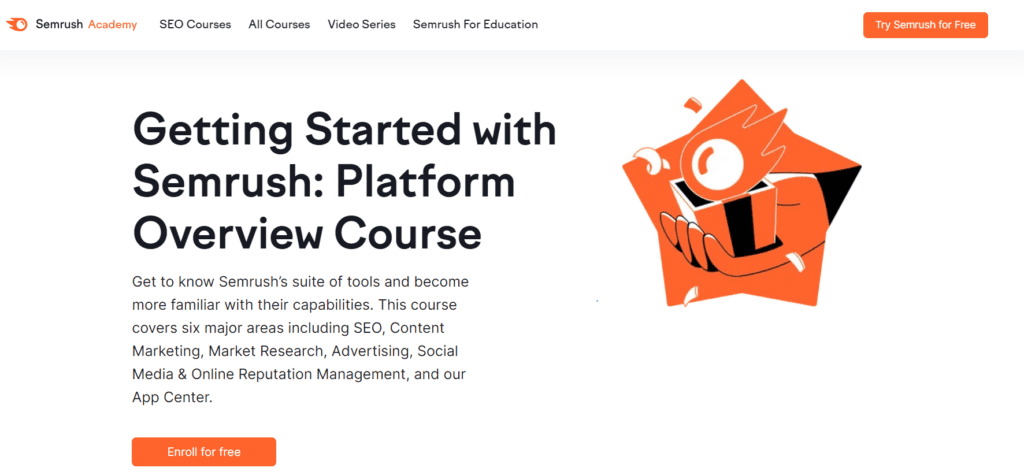

Having an online course also helps you brand yourself as an industry expert or authority figure in your arena. So, don’t overlook this type of content even if it seems like a lot of work.
There are many platforms where you can just upload your content and the platform itself will handle distribution and collecting payments.
You can add plugins to your website to build a gated online course. And you can just use your phone or laptop to record your material.
Focus on creating value and do your best to build a course. Don’t worry about having an elaborate setup or a professional video crew. Just focus on delivering great content that will help your readers.
16. Workshops
Don’t have time for an online course? No worries.
Workshops are a great way to engage with your audience and deliver the same value you would in an online course. But, you do it live and for a limited amount of time – typically an hour.
You can do this in a physical location but today, it’s more common to host online workshops using Zoom, Google Meet, or other tools.
You can even host workshops on social media platforms, like Facebook or Instagram. You can also use this as an opportunity to get people into your sales funnel if you have a course or product that relates to the workshop topic.
Workshops are great for getting feedback from your audience and having meaningful conversations with them. They’re also good for building relationships with potential customers and showing off your knowledge of a certain industry or field.
Blog Posts are Not Enough to Grow Your Business
While blog posts are critical to building your authority, getting more traffic, and driving sales, they’re only part of the recipe.
If you want to create a great content strategy that reaches the most people, you need to think of other formats and platforms.
We’ve looked at options as varied as videos to live workshops. You should focus on the formats for which you have the time and budget.
And you also want to make sure that you align the different types of content to meet your major business goals. Whether it’s making sales, building your reputation, or engaging the community, leverage different formats, and you’ll see growth like never before.
FAQs
Why should you create content other than blog posts?
You should create different types of content and not just blog posts to reach out to people who use other media.
If you have high competition in your area, creating different content formats may give you an edge over your competition.
Also, search engines often showcase different types of content for a specific search term. By creating different content formats, you can rank hire on search engine results pages.
What are the best alternatives for blogging?
Some of the best alternatives are creating video contact for YouTube and social media, creating ebooks, and finally, podcasts.


